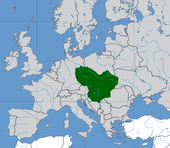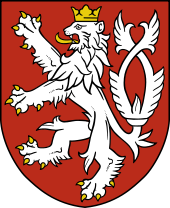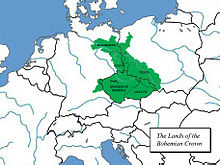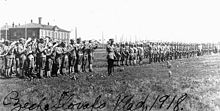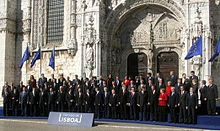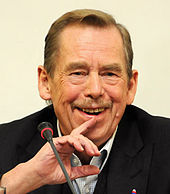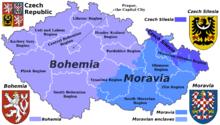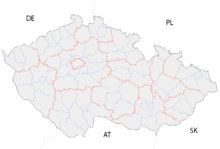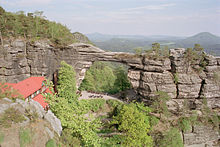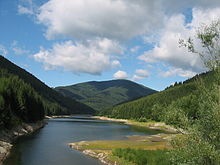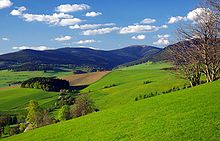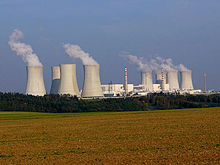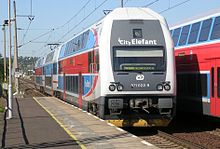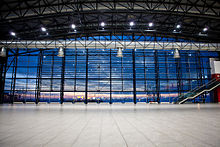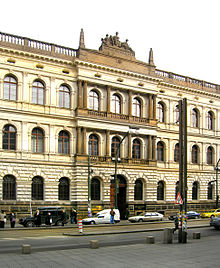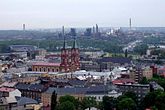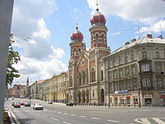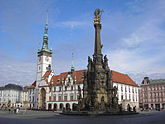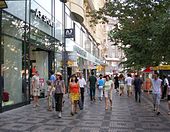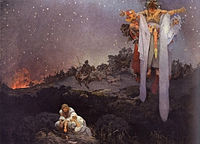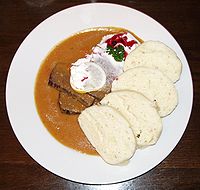
Czech Republic
About this schools Wikipedia selection
SOS Children have produced a selection of wikipedia articles for schools since 2005. To compare sponsorship charities this is the best sponsorship link.
| Czech Republic Česká republika
|
||||||
|---|---|---|---|---|---|---|
|
||||||
| Motto: " Pravda vítězí" ( Czech) "Truth prevails" |
||||||
| Anthem: Kde domov můj? (Czech) Where is my home? a |
||||||
|
Location of the Czech Republic (dark green)
– in Europe (green & dark grey) |
||||||
| Capital and largest city |
Prague (Praha) 50°05′N 14°28′E |
|||||
| Official languages | Czech | |||||
| Officially recognized minority languages |
||||||
| Ethnic groups (2011) |
|
|||||
| Demonym | Czech | |||||
| Government | Parliamentary republic | |||||
| - | President | Miloš Zeman | ||||
| - | Prime Minister | Petr Nečas | ||||
| Legislature | Parliament | |||||
| - | Upper house | Senate | ||||
| - | Lower house | Chamber of Deputies | ||||
| Formation | ||||||
| - | Principality of Bohemia | c. 870 | ||||
| - | Kingdom of Bohemia | 1198 | ||||
| - | Czechoslovakia | 28 October 1918 | ||||
| - | Czech Socialist Republic | 1 January 1969 | ||||
| - | Czech Republic | 1 January 1993 | ||||
| Area | ||||||
| - | Total | 78,866 km2 ( 116th) 30,450 sq mi |
||||
| - | Water (%) | 2 | ||||
| Population | ||||||
| - | Sep 2012 estimate | 10,513,209 ( 81st) | ||||
| - | 2011 census | 10,436,560 | ||||
| - | Density | 134/km2 ( 84th) 341/sq mi |
||||
| GDP ( PPP) | 2012 estimate | |||||
| - | Total | $286.952 billion | ||||
| - | Per capita | $27,190 | ||||
| GDP (nominal) | 2012 estimate | |||||
| - | Total | $196.072 billion | ||||
| - | Per capita | $18,579 | ||||
| Gini (2008) | 26 low · 4th |
|||||
| HDI (2013) | very high · 28th |
|||||
| Currency | Czech koruna ( CZK) |
|||||
| Time zone | CET ( UTC+1) | |||||
| - | Summer ( DST) | CEST ( UTC+2) | ||||
| Drives on the | right | |||||
| Calling code | +420b | |||||
| ISO 3166 code | CZ | |||||
| Internet TLD | .czc | |||||
| a. | The question is rhetorical, implying "those places where my homeland lies". | |||||
| b. | Code 42 was shared with Slovakia until 1997. | |||||
| c. | Also .eu, shared with other European Union member states. | |||||
The Czech Republic ( / ˈ tʃ ɛ k / CHEK; Czech: Česká republika, pronounced [ˈtʃɛskaː ˈrɛpuˌblɪka], short form Česko Czech pronunciation: [ˈtʃɛsko]), is a landlocked country in Central Europe. The country is bordered by Germany to the west, Austria to the south, Slovakia to the east and Poland to the north. Its capital and largest city, with 1.3 million inhabitants, is Prague. The Czech Republic includes the historical territories of Bohemia and Moravia and a small part of Silesia.
The Czech state, formerly known as Bohemia, was formed in the late 9th century as a small duchy around Prague, at that time under the dominance of the powerful Great Moravian Empire. After the fall of the Empire in 907, the centre of power was transferred from Moravia to Bohemia, under the Přemyslids. Since 1002 it was formally recognized as part of the Holy Roman Empire. In 1212 the duchy was raised to a kingdom and during the rule of Přemyslid dukes/kings and their successors, the Luxembourgs, the country reached its greatest territorial extent (13th–14th century). During the Hussite wars the kingdom faced economic embargoes and crusades from all over Europe. Following the Battle of Mohács in 1526, the Kingdom of Bohemia was gradually integrated into the Habsburg monarchy as one of its three principal parts, alongside the Archduchy of Austria and the Kingdom of Hungary. The Bohemian Revolt (1618–20) lost in the Battle of White Mountain, led to Thirty Years War and further centralization of the monarchy including forced recatholization and Germanization. With the dissolution of the Holy Roman Empire in 1806, the Bohemian kingdom became part of the Austrian Empire. In the 19th century the Czech lands became the industrial powerhouse of the monarchy and the core of the Republic of Czechoslovakia which was formed in 1918, following the collapse of the Austro-Hungarian Empire after World War I. After 1933, Czechoslovakia remained the only democracy in central and eastern Europe.
After the Munich Agreement, Polish annexation of Zaolzie and German occupation of Czechoslovakia and the consequent disillusion with the Western response and gratitude for the liberation of the major portion of Czechoslovakia by the Red Army, the Communist Party of Czechoslovakia won the majority in the 1946 elections. In the 1948 coup d'état, Czechoslovakia became a communist-ruled state. In 1968, the increasing dissatisfaction culminated in attempts to reform the communist regime. The events, known as the Prague Spring of 1968, ended with an invasion by the armies of the Warsaw Pact countries (with the exception of Romania); the troops remained in the country until the 1989 Velvet Revolution, when the communist regime collapsed. On 1 January 1993, Czechoslovakia peacefully dissolved into its constituent states, the Czech Republic and the Slovak Republic.
In 2006, the Czech Republic became first former member of the Comecon to achieve the status of a developed country according to the World Bank. In addition, the country has the highest human development in Central and Eastern Europe, ranking as a "Very High Human Development" nation. It is also ranked as the third most peaceful country in Europe and most democratic and healthy (by infant mortality) country in the region. It is a pluralist multi-party parliamentary representative democracy, a member of the European Union, NATO, the OECD, the OSCE, the Council of Europe and the Visegrád Group.
Etymology
The traditional English name "Bohemia" derives from Latin "Boiohaemum", which means "home of the Boii". The current name comes from the endonym Čech, borrowed through Polish and spelt accordingly. The name comes from the Slavic tribe (Czechs, Czech: Čechové) and, according to legend, their leader Čech, who brought them to Bohemia, to settle on Říp Mountain. The etymology of the word Čech can be traced back to the Proto-Slavic root *čel-, meaning "member of the people; kinsman", thus making it cognate to the Czech word člověk (a person).
The country has been traditionally divided into lands, namely Bohemia proper (Čechy) in the west, Moravia (Morava) in the southeast, and Czech Silesia (Slezsko; the smaller, south-eastern part of historical Silesia, most of which is located within modern Poland) in the northeast. Known officially as the "Crown of the Kingdom of Bohemia" since the 14th century, a number of other names for the country have been used, including the Lands of the Bohemian Crown, Czech/Bohemian lands, Bohemian Crown, and the Lands of the Crown of Saint Wenceslas. When the country regained its independence after the dissolution of the Austro-Hungarian empire in 1918, the new name of Czechoslovakia was coined to reflect the union of the Czech and Slovak nations within the one country.
Following the dissolution of Czechoslovakia at the end of 1992, the Czech part of the former nation found itself without a common single-word name in English. In 1993, the Czech Ministry of Foreign Affairs suggested the name Czechia / ˈ tʃ ɛ k i ə / (Česko Czech pronunciation: [ˈtʃɛsko] in Czech) as an official alternative in all situations other than formal official documents and the full names of government institutions; however, this has not become widespread in English.
History
Prehistory
Archaeologists have found evidence of prehistoric human settlements in the area, dating back to the Neolithic era. In the classical era, from the 3rd century BC Celtic migrations, the Boii and later in the 1st century, Germanic tribes of Marcomanni and Quadi settled there. During the Migration Period around the 5th century, many Germanic tribes moved westwards and southwards out of Central Europe.
Slavic people from the Black Sea- Carpathian region settled in the area (a movement that was also stimulated by the onslaught of peoples from Siberia and Eastern Europe: Huns, Avars, Bulgars and Magyars). In the sixth century they moved southwards into Bohemia, Moravia and some of present day Austria. During the 7th century, the Frankish merchant Samo, supporting the Slavs fighting their Avar rulers, became the ruler of the first known Slav state in Central Europe. The Moravian principality arose in the 8th century and reached its zenith in the 9th, when it held off the influence of the Franks and won the protection of the Pope.
Bohemia
The Duchy of Bohemia emerged in the late 9th century, when it was unified by the Přemyslid dynasty. In 10th century Boleslaus I, Duke of Bohemia conquered Moravia, Silesia and expanded farther to the east. The Kingdom of Bohemia was, as the only kingdom in the Holy Roman Empire, a significant regional power during the Middle Ages. It was part of the Empire from 1002 till 1806, with the exception of the years 1440–1526. In 1212, King Přemysl Ottokar I (bearing the title "king" since 1198) extracted the Golden Bull of Sicily (a formal edict) from the emperor, confirming Ottokar and his descendants' royal status; the Duchy of Bohemia was raised to a Kingdom. The bull declared that the Czech king would be exempt from all future obligations to the Holy Roman Empire except for participation in imperial councils. German immigrants settled in the Bohemian periphery in 13th century. Germans populated towns and mining districts and, in some cases, formed German colonies in the interior of Bohemia. In 1235, the Mongols launched an invasion of Europe. After the Battle of Legnica, the Mongols carried their raids into Moravia, but were beaten by the Czech royal army in the battle of Olomouc, where Genghis Khan's grandson Baidar was killed. The Mongols subsequently invaded and defeated Hungary.
King Přemysl Ottokar II earned the nickname "Iron and Golden King" because of his military power and wealth. He acquired Austria, Styria, Carinthia and Carniola, thus spreading the Bohemian territory to the Adriatic Sea. He met his death at the Battle on the Marchfeld in 1278 in a war with his rival, King Rudolph I of Germany. Ottokar's son Wenceslaus II acquired the Polish crown in 1300 for himself and the Hungarian crown for his son. He built a great empire stretching from the Danube river to the Baltic Sea. In 1306, the last king of Přemyslid line was murdered in mysterious circumstances in Olomouc while he was resting. After a series of dynastic wars, the House of Luxembourg gained the Bohemian throne.
The 14th century, in particular, the reign of the Czech king Charles IV (1316–1378), who also became the King of Italy, King of the Romans and Holy Roman Emperor, is considered the Golden Age of Czech history. Of particular significance was the founding of Charles University in Prague in 1348, Charles Bridge, Charles Square. Much of Prague Castle and the cathedral of Saint Vitus were completed during his reign. He unified Brandenburg (until 1415), Lusatia (until 1635), and Silesia (until 1742) under the Czech crown. The Black Death, which had raged in Europe from 1347 to 1352, decimated the Kingdom of Bohemia in 1380, killing about 10% of the population.
In the 15th century, the religious and social reformer Jan Hus formed a movement later named after him. Although Hus was named a heretic and burnt in Constance in 1415, his followers seceded from the Catholic Church and in the Hussite Wars (1419–1434) defeated five crusades organized against them by the Holy Roman Emperor Sigismund. Petr Chelčický continued with the Czech Hussite Reformation movement. During the next two centuries, 90% of the inhabitants became adherents of the Hussite Christian movement.
After 1526 Bohemia came increasingly under Habsburg control as the Habsburgs became first the elected and then the hereditary rulers of Bohemia. The Defenestration of Prague and subsequent revolt against the Habsburgs in 1618 marked the start of the Thirty Years' War, which quickly spread throughout Central Europe. In 1620, the rebellion in Bohemia was crushed at the Battle of White Mountain, and the ties between Bohemia and the Habsburgs' hereditary lands in Austria were strengthened. The war had a devastating effect on the local population; the people were given the choice either to convert to Catholicism or leave the country.
The following period, from 1620 to the late 18th century, has colloquially often been called the "Dark Age". The population of the Czech lands declined by a third through war, disease, famine and the expulsion of Protestant Czechs. The Habsburgs banned all religions other than Catholicism. Ottoman Turks and Tatars invaded Moravia in 1663. In 1679–1680 the Czech lands faced a devastating plague and an uprising of serfs.
The reigns of Maria Theresa of Austria and her son Joseph II, Holy Roman Emperor and co-regent from 1765, were characterized by enlightened absolutism. In 1742, most of Silesia, then the possession of the Bohemian crown, was seized by King Frederick II of Prussia in the War of the Austrian Succession. The Great Famine, which lasted from 1770 until 1771, killed about one tenth of the Czech population, or 250,000 inhabitants, and radicalized countrysides leading to peasant uprisings.
After the fall of the Holy Roman Empire, Bohemia became part of the Austrian Empire and later of Austria–Hungary. Serfdom was not completely abolished until 1848. After the Revolutions of 1848, Emperor Franz Josef I of Austria instituted an absolute monarchy in an effort to balance competing ethnic interests in the empire.
Czechoslovakia
An estimated 1.4 million Czech soldiers fought in World War I, of whom some 150,000 died. More than 90,000 Czech volunteers formed the Czechoslovak Legions in France, Italy and Russia, where they fought against the Central Powers and later against Bolshevik troops. Following the collapse of the Austro-Hungarian Empire after World War I, the independent republic of Czechoslovakia was created in 1918. This new country incorporated the Bohemian Crown (Bohemia, Moravia and Silesia) and parts of the Kingdom of Hungary (Slovakia and the Carpathian Ruthenia) with significant German, Hungarian, Polish and Ruthenian speaking minorities.

Although Czechoslovakia was a unitary state, it provided what were at the time rather extensive rights to its minorities and remained the only democracy in this part of Europe in the interwar period. The effects of the Great Depression including high unemployment and massive propaganda from Nazi Germany, however, resulted in discontent and strong support among ethnic Germans for a break from Czechoslovakia. Adolf Hitler took advantage of this opportunity and, using Konrad Henlein's separatist Sudeten German Party, gained the largely German speaking Sudetenland (and its substantial Maginot Line-like border fortifications) through the 1938 Munich Agreement (signed by Nazi Germany, France, Britain and Italy), despite the mobilization of 1.2 million-strong Czechoslovak army and the Franco-Czech military alliance. Poland annexed the Zaolzie area around Český Těšín. Hungary gained parts of Slovakia and the Subcarpathian Rus as a result of the First Vienna Award in November 1938.
The remainders of Slovakia and the Subcarpathian Rus gained greater autonomy, with the state renamed to "Czecho-Slovakia". After Nazi Germany threatened to annex part of Slovakia, allowing the remaining regions to be partitioned by Hungary and Poland, Slovakia chose to maintain its national and territorial integrity, seceding from Czecho-Slovakia in March 1939, and allying itself, as demanded by Germany, with Hitler's coalition.
The remaining Czech territory was occupied by Germany, which transformed it into the so-called Protectorate of Bohemia and Moravia. The protectorate was proclaimed part of the Third Reich, and the president and prime minister were subordinate to the Nazi Germany's Reichsprotektor ("imperial protector"). Subcarpathian Rus declared independence as the Republic of Carpatho-Ukraine on 15 March 1939 but was invaded by Hungary the same day and formally annexed the next day. Approximately 345,000 Czechoslovak citizens, including 277,000 Jews, were killed or executed while hundreds of thousands of others were sent to prisons and concentration camps or used as forced labour. Perhaps two–thirds of the Czech nation was destined either for extermination or removal. A Nazi German concentration camp existed at Terezín, north of Prague.
There was a strong Czech resistance to Nazi occupation, both at home and abroad, most notably with the assassination of Nazi German leader Reinhard Heydrich by Czechoslovakian soldiers Jozef Gabčík and Jan Kubiš in a Prague suburb on 27 May 1942. The Czechoslovak government-in-exile and its army fighting against the Germans were acknowledged by the Allies; Czech/Czechoslovak troops fought from the very beginning of the war in Poland, France, the UK, North Africa, the Middle East and the Soviet Union. The German occupation ended on 9 May 1945, with the arrival of the Soviet and American armies and the Prague uprising. An estimated 140,000 Soviet soldiers died in liberating Czechoslovakia from German rule.
In 1945–1946, almost the entire German minority in Czechoslovakia, about 3 million people, were expelled to Germany and Austria. During this time, thousands of Germans were held in prisons and detention camps or used as forced labour. In the summer of 1945, there were several massacres. The only Germans not expelled were some 250,000 who had been active in the resistance against the Nazi Germans or were considered economically important, though many of these emigrated later. Following a Soviet-organised referendum, the Subcarpathian Rus never returned under Czechoslovak rule but became part of the Ukrainian Soviet Socialist Republic, as the Zakarpattia Oblast in 1946.
Czechoslovakia uneasily tried to play the role of a "bridge" between the West and East. However, the Communist Party of Czechoslovakia rapidly increased in popularity, with a general disillusionment with the West, because of the pre-war Munich Agreement, and a favourable popular attitude towards the Soviet Union, because of the Soviets' role in liberating Czechoslovakia from German rule. In the 1946 elections, the Communists gained 38% of the votes and became the largest party in the Czechoslovak parliament. They formed a coalition government with other parties of the National Front and moved quickly to consolidate power. The decisive step took place in February 1948, during a series of events characterized by Communists as a "revolution" and by anti-Communists as a "takeover", the Communist People's Militias secured control of key locations in Prague, and a new all-Communist government was formed.
For the next 41 years, Czechoslovakia was a Communist state within the Eastern Bloc. This period is characterized by lagging behind the West in almost every aspect of social and economic development. The country's GDP per capita fell from the level of neighboring Austria below that of Greece or Portugal in the 1980s. The Communist government completely nationalized the means of production and established a command economy. The economy grew rapidly during the 1950s but slowed down in the 1960s and 1970s and stagnated in the 1980s. The political climate was highly repressive during the 1950s, including numerous show trials and hundreds of thousands of political prisoners, but became more open and tolerant in the late 1960s, culminating in Alexander Dubček's leadership in the 1968 Prague Spring, which tried to create "socialism with a human face" and perhaps even introduce political pluralism. This was forcibly ended by invasion of all Warsaw Pact member countries with the exception of Romania and Albania on 21 August 1968.
The invasion was followed by a harsh program of " Normalization" in the late 1960s and the 1970s. Until 1989, the political establishment relied on censorship of the opposition. Dissidents published Charter 77 in 1977, and the first of a new wave of protests were seen in 1988. Between 1948 and 1989 more than 250,000 Czechs and Slovaks were sent to prison for "anti-state activities" and over 400,000 emigrated.
Velvet revolution and independence
In November 1989, Czechoslovakia returned to a liberal democracy through the peaceful " Velvet Revolution". However, Slovak national aspirations strengthened and on 1 January 1993, the country peacefully split into the independent Czech Republic and Slovakia. Both countries went through economic reforms and privatisations, with the intention of creating a capitalist economy. This process was largely successful; in 2006 the Czech Republic was recognised by the World Bank as a "developed country", and in 2009 the Human Development Index ranked it as a nation of "Very High Human Development".
From 1991, the Czech Republic, originally as part of Czechoslovakia and since 1993 in its own right, has been a member of the Visegrád Group and from 1995, the OECD. The Czech Republic joined NATO on 12 March 1999 and the European Union on 1 May 2004. It held the Presidency of the European Union for the first half of 2009.
Politics
The Czech Republic is a pluralist multi-party parliamentary representative democracy, with the Prime Minister as head of government. The Parliament (Parlament České republiky) is bicameral, with the Chamber of Deputies ( Czech: Poslanecká sněmovna) (200 members) and the Senate ( Czech: Senát) (81 members).
The President of the Czech Republic was being selected by a joint session of the parliament for a five-year term, with no more than two consecutive terms. This system was practised between years 1993–2012. Since 2013 the presidential election is direct. The president is a formal head of state with limited specific powers, most importantly to return bills to the parliament, nominate constitutional court judges for the Senate's approval and dissolve the parliament under certain special and unusual circumstances. He also appoints the prime minister, as well the other members of the cabinet on a proposal by the prime minister. From 2013 on, the president is elected by the public, not the parliament. Miloš Zeman was the first directly elected Czech President.
The Prime Minister is the head of government and wields considerable powers, including the right to set the agenda for most foreign and domestic policy, mobilize the parliamentary majority and choose government ministers.
The members of the Chamber of Deputies are elected for a four-year term by proportional representation, with a 5% election threshold. There are 14 voting districts, identical to the country's administrative regions. The Chamber of Deputies, the successor to the Czech National Council, has the powers and responsibilities of the now defunct federal parliament of the former Czechoslovakia.
The members of the Senate are elected in single-seat constituencies by two-round runoff voting for a six-year term, with one-third elected every even year in the autumn. The first election was in 1996, for differing terms. This arrangement is modeled on the U.S. Senate, but each constituency is roughly the same size and the voting system used is a two-round runoff. The Senate is unpopular among the public and suffers from low election turnout, overall roughly 30% in the first round and 20% in the second.
Foreign relations
Membership in the European Union is central in Czech Republic's foreign policy. The Czech Republic held the Presidency of the Council of the European Union for the first half of 2009.
Czech officials have supported dissenters in Burma, Belarus, Moldova and Cuba.
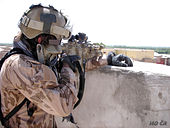
Military
The Czech armed forces consist of the Army, Air Force and of specialized support units. The president of the Czech Republic, is Commander-in-Chief of the armed forces. In 2004 the army transformed itself into a fully professional organization and compulsory military service was abolished. The country has been a member of NATO since 12 March 1999. Defense spending is around 1.8% of the GDP (2006). Currently, as a member of NATO, the Czech military are participating in ISAF and KFOR operations and have soldiers in Afghanistan and Kosovo. Main equipment includes: multi-role fighters JAS-39 Gripen, combat aircraft Aero L-159 Alca, attack helicopters Mi-24, armored vehicles Pandur II, OT-64, OT-90, BVP-2 and Czech modernized tanks T-72 (T-72M4CZ).
Administrative divisions
Since 2000, the Czech Republic is divided into thirteen regions ( Czech: kraje, singular kraj) and the capital city of Prague. Each region has its own elected Regional Assembly (krajské zastupitelstvo) and hejtman (usually translated as hetman or "president"). In Prague, their powers are executed by the city council and the mayor.
The older seventy-six districts (okresy, singular okres) including three "statutory cities" (without Prague, which had special status) lost most of their importance in 1999 in an administrative reform; they remain as territorial divisions and seats of various branches of state administration.
| ( Lic. plate) | Region | Administrative seat | Population (2004 est.) | Population (2010 est.) |
|---|---|---|---|---|
| A | 1,170,571 | 1,251,072 | ||
| S | |
offices located in Prague (Praha) | 1,144,071 | 1,256,850 |
| C | |
České Budějovice | 625,712 | 637,723 |
| P | |
Plzeň | 549,618 | 571,831 |
| K | |
Karlovy Vary | 304,588 | 307,380 |
| U | |
Ústí nad Labem | 822,133 | 835,814 |
| L | |
Liberec | 427,563 | 439,458 |
| H | |
Hradec Králové | 547,296 | 554,370 |
| E | |
Pardubice | 505,285 | 516,777 |
| M | |
Olomouc | 635,126 | 641,555 |
| T | |
Ostrava | 1,257,554 | 1,244,837 |
| B | |
Brno | 1,123,201 | 1,152,819 |
| Z | |
Zlín | 590,706 | 590,527 |
| J | |
Jihlava | 517,153 | 514,805 |
Geography
The Czech Republic lies mostly between latitudes 48° and 51° N (a small area lies north of 51°), and longitudes 12° and 19° E.
The Czech landscape is exceedingly varied. Bohemia, to the west, consists of a basin drained by the Elbe ( Czech: Labe) and the Vltava (or Moldau) rivers, surrounded by mostly low mountains, such as the Krkonoše range of the Sudetes. The highest point in the country, Sněžka at 1,602 m (5,256 ft), is located here. Moravia, the eastern part of the country, is also quite hilly. It is drained mainly by the Morava River, but it also contains the source of the Oder River ( Czech: Odra).
Water from the landlocked Czech Republic flows to three different seas: the North Sea, Baltic Sea and Black Sea. The Czech Republic also leases the Moldauhafen, a 30,000-square-metre (7.4-acre) lot in the middle of the Hamburg Docks, which was awarded to Czechoslovakia by Article 363 of the Treaty of Versailles, to allow the landlocked country a place where goods transported down river could be transferred to seagoing ships. The territory reverts to Germany in 2028.
Phytogeographically, the Czech Republic belongs to the Central European province of the Circumboreal Region, within the Boreal Kingdom. According to the World Wide Fund for Nature, the territory of the Czech Republic can be subdivided into four ecoregions: the Central European mixed forests, Pannonian mixed forests, Western European broadleaf forests and Carpathian montane conifer forests.
There are four national parks in the Czech Republic. The oldest is Krkonoše National Park ( Biosphere Reserve), Šumava National Park (Biosphere Reserve), Podyjí National Park, Bohemian Switzerland.
Climate
The Czech Republic has a temperate continental climate, with relatively hot summers and cold, cloudy and snowy winters. The temperature difference between summer and winter is relatively high, due to the landlocked geographical position.
Within the Czech Republic, temperatures vary greatly, depending on the elevation. In general, at higher altitudes, the temperatures decrease and precipitation increases. The wettest area in the Czech Republic is found around Bílý Potok in Jizera Mountains and the driest region is the Louny District to the northwest of Prague. Another important factor is the distribution of the mountains; therefore, the climate is quite varied.
At the highest peak of Sněžka (1,602 m or 5,256 ft), the average temperature is only −0.4 °C (31 °F), whereas in the lowlands of the South Moravian Region, the average temperature is as high as 10 °C (50 °F). The country's capital, Prague, has a similar average temperature, although this is influenced by urban factors.
The coldest month is usually January, followed by February and December. During these months, there is usually snow in the mountains and sometimes in the major cities and lowlands. During March, April and May, the temperature usually increases rapidly, especially during April, when the temperature and weather tends to vary widely during the day. Spring is also characterized by high water levels in the rivers, due to melting snow with occasional flooding.
The warmest month of the year is July, followed by August and June. On average, summer temperatures are about 20 °C higher than during winter. Temperatures above 30 °C (86 °F) are not unusual. Summer is also characterized by rain and storms.
Autumn generally begins in September, which is still relatively warm and dry. During October, temperatures usually fall below 15 °C (59 °F) or 10 °C (50 °F) and deciduous trees begin to shed their leaves. By the end of November, temperatures usually range around the freezing point.
The coldest temperature ever measured was in Litvínovice near České Budějovice in 1929, at −42.2 °C (−44.0 °F) and the hottest measured, was at 40.4 °C (104.7 °F) in Dobřichovice in 2012.
Most rain falls during the summer. Sporadic rainfall is relatively constant throughout the year (in Prague, the average number of days per month experiencing at least 0.1 mm of rain varies from 12 in September and October to 16 in November) but concentrated heavy rainfall (days with more than 10 mm per day) are more frequent in the months of May to August (average around two such days per month).
Economy
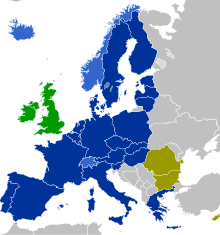
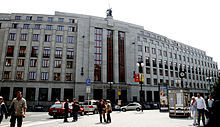
The Czech Republic possesses a developed, high-income economy with a GDP per capita of 80% of the European Union average. One of the most stable and prosperous of the post-Communist states, the Czech Republic saw growth of over 6% annually in the three years before the outbreak of the recent global economic crisis. Growth has been led by exports to the European Union, especially Germany, and foreign investment, while domestic demand is reviving.
Most of the economy has been privatised, including the banks and telecommunications. The current centre-right government plans to continue with privatisation, including the energy industry and the Prague airport. It has recently agreed to the sale of a 7% stake in the energy producer, CEZ Group, with the sale of the Budějovický Budvar brewery also mooted. A 2009 survey in cooperation with the Czech Economic Association found that the majority of Czech economists favour continued liberalization in most sectors of the economy.
The country is part of the Schengen Area from 1 May 2004, having abolished border controls, completely opening its borders with all of its neighbours, Germany, Austria, Poland and Slovakia, on 21 December 2007. The Czech Republic became a member of the World Trade Organisation.
The last Czech government led by social democrats had expressed a desire to adopt the euro in 2010, but the current centre-right government suspended that plan in 2007. An exact date has not been set up, but the Finance Ministry described adoption by 2012 as realistic, if public finance reform passes. However, the most recent draft of the euro adoption plan omits giving any date. Although the country is economically better positioned than other EU Members to adopt the euro, the change is not expected before 2019, due to political reluctance on the matter.
The Programme for International Student Assessment, coordinated by the OECD, currently ranks the Czech education system as the 15th best in the world, higher than the OECD average. The Czech Republic is ranked 30th in the 2012 Index of Economic Freedom.
Transportation infrastructure
Václav Havel Airport in Prague is the main international airport in the country. In 2010, it handled 11.6 million passengers, which makes it the busiest airport in Central and Eastern Europe. In total, Czech Republic has 46 airports with paved runways, six of which provide international air services in Brno, Karlovy Vary, Mošnov (near Ostrava), Pardubice, Prague and Kunovice (near Uherské Hradiště).
České dráhy (the Czech railways) is the main railway operator in the Czech Republic, with about 180 million passengers carried yearly. Its cargo division, ČD Cargo, is the fifth largest railway cargo operator in the European Union. With 9,505 km (5,906.13 mi) of tracks, the Czech Republic has one of the densest railway networks in Europe. Of that number, 2,926 km (1,818.13 mi) is electrified, 7,617 km (4,732.98 mi) are single-line tracks and 1,866 km (1,159.48 mi) are double and multiple-line tracks. In 2006 the new Italian tilting trains Pendolino ČD Class 680 entered service. They have reached a speed of 237 km/h setting a new Czech railway speed record.
In 2005, according to the Czech Statistical Office, 65.4 percent of electricity was produced by steam, combined and combustion power plants (mostly coal); 30 percent in nuclear plants; and 4.6 percent from renewable sources, including hydropower. Russia, via pipelines through Ukraine and to a lesser extent, Norway, via pipelines through Germany, supply the Czech Republic with liquid and natural gas.
The Czech Republic is reducing its dependence on highly polluting low-grade brown coal as a source of energy. Nuclear power presently provides about 30 percent of the total power needs, its share is projected to increase to 40 percent. Natural gas is procured from Russian Gazprom, roughly three-fourths of domestic consumption and from Norwegian companies, which make up most of the remaining one-fourth. Russian gas is imported via Ukraine ( Druzhba pipeline), Norwegian gas is transported through Germany. Gas consumption (approx. 100 TWh in 2003–2005) is almost double electricity consumption. South Moravia has small oil and gas deposits.
The road network in the Czech Republic is 55,653 km (34,581.17 mi) long. and 738,4 km of motorways and 439,1 km of expressways. The speed limit is 50 km/h within towns, 90 km/h outside of towns and 130 km/h on expressways.
Communications
The Czech Republic ranks in the top 10 countries worldwide with the fastest average internet speed. The Czech Republic has the most Wi-Fi subscribers in the European Union. By the beginning of 2008, there were over 800 mostly local WISPs, with about 350,000 subscribers in 2007. Plans based on either GPRS, EDGE, UMTS or CDMA2000 are being offered by all three mobile phone operators ( T-Mobile, Vodafone, Telefónica O2) and internet provider U:fon. Government-owned Český Telecom slowed down broadband penetration. At the beginning of 2004, local-loop unbundling began and alternative operators started to offer ADSL and also SDSL. This and later privatisation of Český Telecom helped drive down prices.
On 1 July 2006, Český Telecom was acquired by globalized company (Spain owned) Telefónica group and adopted new name Telefónica O2 Czech Republic. As of April 2012, VDSL and ADSL2+ are offered in many variants, without with speeds up to 25 Mbit/s. Cable internet is gaining popularity with its higher download speeds beginning at 2 Mbit/s up to 120 Mbit/s.
Science
The Czech lands have a rich scientific tradition. Important inventions include the modern contact lens, the separation of modern blood types, and the production of the Semtex plastic explosive. Prominent scientists who lived and worked in historically Czech lands include:
- John Amos Comenius (1592–1670), teacher, educator and the founder of modern education.
- Václav Prokop Diviš (1698–1765), inventor of the first grounded lightning rod.
- Bernard Bolzano (1781–1848), noted mathematician, logician, philosopher, and pacifist.
- Jan Evangelista Purkyně (1787–1869), anatomist and physiologist responsible for the discovery of Purkinje cells, Purkinje fibres and sweat glands, as well as Purkinje images and the Purkinje shift.
- Josef Ressel (1793–1857), inventor of the screw propeller and modern compass.
- Jakub Kryštof Rad (1799–1871), inventor of the sugar cubes.
- Gregor Mendel (1822–1884), often called the "father of genetics", is famed for his research concerning the inheritance of genetic traits.
- Jakub Husník (1837–1916), inventor of the improved photolithography.
- Karel Klíč (1841–1926), painter and photographer, inventor of the photogravure.
- František Křižík (1847–1941), electrical engineer, inventor of the arc lamp.
- Jan Janský (1873–1921), serologist and neurologist, discovered classification of blood into the four types.
- Bedřich Hrozný (1879–1952), deciphered the Hittite language.
- Josef Čapek (1887–1945) and Karel Čapek (1890–1938), brothers who originated the word robot.
- František Burian and Arnold Jirásek, founded the first plastic surgery in 1927.
- Jaroslav Heyrovský (1890–1967), inventor of the polarography, electroanalytical chemistry and recipient of the Nobel Prize.
- Otto Wichterle (1913–1998) and Drahoslav Lím (1925–2003), Czech chemists responsible for the invention of the modern contact lens and silon ( Synthetic fibre).
- Stanislav Brebera (1925–2012), inventor of the plastic explosive Semtex.
- Oldřich Homuta, inventor of Remoska owen in 1957.
- Ladislav Mareš, inventor of the first machine producing nanofibres, "Nanospider".
- Antonín Holý (1936–2012), scientist and chemist, in 2009 was involved in creation of the most effective drug in the treatment of AIDS.
A number of other scientists are also connected in some way with the Czech Lands, including astronomers Johannes Kepler and Tycho Brahe, the founder of the psychoanalytic school of psychiatry Sigmund Freud, physicists Ernst Mach, Nikola Tesla, Albert Einstein, engineer Viktor Kaplan and logician Kurt Gödel.
Tourism
The Czech economy gets a substantial income from tourism. In 2011, Prague was the sixth most visited city in Europe. In 2001, the total earnings from tourism reached 118.13 billion CZK, making up 5.5% of GNP and 9.3% of overall export earnings. The industry employs more than 110,000 people – over 1% of the population. In 2008, however, there was a slump in tourist numbers in Prague, possibly due to the strong Czech koruna (crown) making the country too expensive for visitors, compared to the level of services that were available.
The country's reputation has also suffered with guidebooks and tourists reporting overcharging by taxi drivers and pickpocketing problems. Since 2005, Prague's mayor, Pavel Bém, has worked to improve this reputation by cracking down on petty crime and, aside from these problems, Prague is a safe city. Also, the Czech Republic as a whole generally has a low crime rate. For tourists, the Czech Republic is considered a safe destination to visit. The low crime rate makes most cities and towns safe to walk around even after dark.
There are several centres of tourist activity. The spa towns, such as Karlovy Vary, Mariánské Lázně and Františkovy Lázně, are particularly popular holiday destinations. Other popular tourist sites are the many castles and chateaux, such as those at Karlštejn Castle, Český Krumlov and the Lednice–Valtice area. There are 15 churches elevated to the rank of basilica by the Pope. Away from the towns, areas such as Český ráj, Šumava and the Krkonoše Mountains attract visitors seeking outdoor pursuits.
The country is also famous for its love of puppetry and marionettes with a number of puppet festivals throughout the country.
Aquapalace Praha in Čestlice near Prague, is the biggest water park in central Europe.
The Czech Republic also has a number of beer festivals, including: Czech Beer Festival (the biggest Czech beer festival, it is 17 days long and held every year in May in Prague), Pilsner Fest (every year in August in Plzeň), The "Olomoucký pivní festival" (in Olomouc) or festival "Slavnosti piva v Českých Budějovicích" (in České Budějovice).
Demographics
|
|
Rank | City | Region | Population | Metropolitan area | |||||
|---|---|---|---|---|---|---|---|---|---|---|
| 1 | Prague | Prague, the Capital City | 1,272,690 | 2,300,000 | ||||||
| 2 | Brno | South Moravian | 378,965 | 729,510 | ||||||
| 3 | Ostrava | Moravian-Silesian | 310 464 | 1,164,328 | ||||||
| 4 | Plzeň | Plzeň | 172,932 | 380,000 | ||||||
| 5 | Liberec | Liberec | 104,946 | 270,000 | ||||||
| 6 | Olomouc | Olomouc | 102,004 | 480,000 | ||||||
| 7 | Ústí nad Labem | Ústí nad Labem | 100,003 | - | ||||||
| 8 | Hradec Králové | Hradec Králové | 94,242 | - | ||||||
| 9 | České Budějovice | South Bohemian | 93,883 | 190,000 | ||||||
| 10 | Pardubice | Pardubice | 91,073 | - | ||||||
| 11 | Havířov | Moravian-Silesian | 82,679 | - | ||||||
| 12 | Zlín | Zlín | 76,010 | 450 000 | ||||||
| 13 | Kladno | Central Bohemian | 70,178 | - | ||||||
| 14 | Most | Ústí nad Labem | 67,058 | 95,316 | ||||||
| 15 | Karviná | Moravian-Silesian | 59,627 | - | ||||||
| 16 | Opava | Moravian-Silesian | 58,643 | - | ||||||
| 17 | Frýdek-Místek | Moravian-Silesian | 58,193 | - | ||||||
| 18 | Karlovy Vary | Karlovy Vary | 53,737 | - | ||||||
| 19 | Jihlava | Vysočina | 50,760 | - | ||||||
| 20 | Děčín | Ústí nad Labem | 50,620 | - | ||||||
| Historical population | ||
|---|---|---|
| Year | Pop. | ±% |
| 1857 | 7,016,531 | — |
| 1869 | 7,617,230 | +8.6% |
| 1880 | 8,222,013 | +7.9% |
| 1890 | 8,665,421 | +5.4% |
| 1900 | 9,372,214 | +8.2% |
| 1910 | 10,078,637 | +7.5% |
| 1921 | 10,009,587 | −0.7% |
| 1930 | 10,674,386 | +6.6% |
| 1950 | 8,896,133 | −16.7% |
| 1961 | 9,571,531 | +7.6% |
| 1970 | 9,807,697 | +2.5% |
| 1980 | 10,291,927 | +4.9% |
| 1991 | 10,302,215 | +0.1% |
| 2001 | 10,230,060 | −0.7% |
| 2011 | 10,436,560 | +2.0% |
According to preliminary results of the 2011 census, the majority of the inhabitants of the Czech Republic are Czechs (63.7%), followed by Moravians (4.9%), Slovaks (1.4%), Poles (0.4%), Germans (0.2%) and Silesians (0.1%). As the 'nationality' was an optional item, a substantial number of people left this field blank (26.0%). According to some estimates, there are about 250,000 Romani people in the Czech Republic.
There were 436,116 foreigners residing in the country in October 2009, according to the Czech Interior Ministry, with the largest groups being Ukrainian (132,481), Slovak (75,210), Vietnamese (61,102), Russian (29,976), Polish (19,790), German (14,156), Moldovan (10,315), Bulgarian (6,346), Mongolian (5,924), American (5,803), Chinese (5,314), British (4,461), Belarusian (4,441), Serbian (4,098), Romanian (4,021), Kazakh (3,896), Austrian (3,114), Italian (2,580), Dutch (2,553), French (2,356), Croatian (2,351), Bosnian (2,240), Armenian (2,021), Uzbek (1,969), Macedonian (1,787) and Japanese (1,581).
The Jewish population of Bohemia and Moravia, 118,000 according to the 1930 census, was virtually annihilated by the Nazi Germans during the Holocaust. There were approximately 4,000 Jews in the Czech Republic in 2005. The former Czech prime minister, Jan Fischer, is of Jewish origin and faith.
Estimates of Czech fertility rate in 2012 are among the lowest in the world at 1.27 children per woman. Immigration increased the population by almost 1% in 2007. About 77,000 new foreigners settle down in the Czech Republic every year. Vietnamese immigrants began settling in the Czech Republic during the Communist period, when they were invited as guest workers by the Czechoslovak government. In 2009, there were about 70,000 Vietnamese in the Czech Republic. In contrast to Ukrainians, Vietnamese come to the Czech Republic to live permanently.
At the turn of the 20th century, Chicago was the city with the third largest Czech population, after Prague and Vienna. According to the 2006 US census, there are 1,637,218 Americans of full or partial Czech descent.
Religion
The Czech Republic has one of the least religious populations in the world. Historically, the Czech people have been characterised as "tolerant and even indifferent towards religion". According to the 2011 census, 34.2% of the population stated they had no religion, 10.3% was Roman Catholic, 0.8% was Protestant (0.5% Czech Brethren and 0.4% Hussite), and 9.4% followed other forms of religion both denominational or not (of which 863 people answered they are Pagan) 45.2% of the population did not answer the question about religion. From 1991 to 2001 and further to 2011 the adherence to Roman Catholicism decreased from 39.0 to 26.8 and then to 10.3; Protestantism similarly declined from 3.7% to 2.1% and then to 0.8%.
According to a Eurobarometer Poll in 2010, 16% of Czech citizens responded that "they believe there is a God" (the lowest rate among the countries of the European Union), whereas 44% answered that "they believe there is some sort of spirit or life force" and 37% said that "they do not believe there is any sort of spirit, God or life force".
Culture

Music
Music in the Czech Republic has its roots in more than 1,000 year old sacred music (the first surviving references come from the end of the 10th century), in the traditional folk music of Bohemia, Moravia and Silesia and in the long-term high-culture classical music tradition. Since the early eras of artificial music, Czech musicians and composers have often been influenced by genuine folk music. Notable Czech composers include Antonín Dvořák, Bedřich Smetana, Gustav Mahler (he was born and grew up in the Czech lands), Adam Michna, Jan Dismas Zelenka, Josef Mysliveček, Leoš Janáček, Josef Suk, Bohuslav Martinů, Erwin Schulhoff and Petr Eben.
Literature
Czech literature is the literature written by Czechs, mostly in the Czech language, although other languages like Old Church Slavonic, Latin or German have been also used, especially in the past. Non-Czech inhabitants of the Czech lands who had written in German and other languages, such as Franz Kafka, are usually excluded from the corpus of Czech literature, regardless of their own national self-identification.
Czech literature is divided into several main time periods: the Middle Ages; the Hussite period; the years of re-Catholicization and the baroque; the Enlightenment and Czech reawakening in the 19th century; the avantgarde of the interwar period; the years under Communism and the Prague Spring; and the literature of the post-Communist Czech Republic. Czech literature and culture played a major role on at least two occasions, when Czechs lived under oppression and political activity was suppressed. On both of these occasions, in the early 19th century and then again in the 1960s, the Czechs used their cultural and literary effort to strive for political freedom, establishing a confident, politically aware nation.
Theatre
Theatre of the Czech Republic has rich tradition with roots in the Middle Ages. In the 19th century, the theatre played an important role in the national awakening movement and later, in the 20th century it became a part of the modern European theatre art.
Film
The Barrandov Studios in Prague are the largest film studios in country and one of the largest in Europe. The Czech Republic has many popular film locations. Filmmakers have come to Prague to shoot scenery no longer found in Berlin, Paris and Vienna. The city of Karlovy Vary was used as a location for the 2006 James Bond film Casino Royale.
Art
The Czech Republic is known worldwide for its individually made, mouth blown and decorated art glass and crystal. One of the best Czech painter and decorative artist was Alphonse Mucha (1860–1939) mainly known for art nouveau posters and his cycle of 20 large canvases named The Slav Epic, which depicts the history of Czechs and other Slavic peoples. The Slav Epic can be since 2012 seen in Veletržní Palace of National Gallery in Prague, which manages the largest collection of art in the Czech Republic.
Cuisine
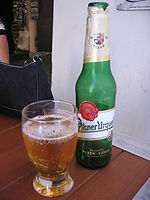
Czech cuisine is marked by a strong emphasis on meat dishes. Pork is quite common; beef and chicken are also popular. Goose, duck, rabbit and wild game are served. Fish is rare, with the occasional exception of fresh trout and carp, which is served at Christmas.
Czech beer has a long and important history. The first brewery is known to have existed in 1118 and the Czech Republic has the highest beer consumption per capita in the world. The famous Pilsener style beer originated in the western Bohemian city of Plzeň, and further south the town of České Budějovice, known as Budweis in German, lent its name to its beer, eventually known as Budweiser Budvar. Apart from these and other major brands, the Czech Republic also boasts a growing number of top quality small breweries and mini-breweries seeking to continue the age-old tradition of quality and taste, whose output matches the best in the world: Štiřín, Chýně, Oslavany, Kácov. Tourism is slowly growing around the Southern Moravian region too, which has been producing wine since the Middle Ages; about 94% of vineyards in the Czech Republic are Moravian. Aside from Slivovitz, Czech beer and wine, the Czechs also produce two unique liquors, Fernet Stock and Becherovka. Kofola is a non-alcoholic domestic cola soft drink which competes with Coca Cola and Pepsi in popularity.
Unique Czech dishes include roast pork with bread dumplings and stewed cabbage Vepřo-knedlo-zelo, roast sirloin beef with steamed dumplings and cream-of-vegetable sauce Svíčková na smetaně, tomato sauce Rajská or dill sauce Koprovka, roast duck with bread or potato dumplings and braised red cabbage, a variety of beef and pork goulash stews Guláš, fried cheese Smažák or the famous potato pancakes Bramboráky, besides a large variety of delicate local sausages, wurst, pâtés and smoked meats and other traditional local foods. Czech desserts include a wide variety of whipped cream, chocolate and fruit pastries and tarts, crepes, creme desserts and cheese, poppy seed filled and other types of traditional cakes buchty and koláče.
Sports
Sports play a part in the life of many Czechs, who are generally loyal supporters of their favorite teams or individuals. The three leading sports in the Czech Republic are ice hockey, football and sport shooting, with the first two drawing the largest attention of both the media and supporters. Tennis is also a very popular sport in the Czech Republic. The many other sports with professional leagues and structures include basketball, volleyball, team handball, track and field athletics and floorball. The Czech ice hockey team won the gold medal at the 1998 Winter Olympics and has won six gold medals at the World Championships including three straight from 1999 to 2001. In total the country has won 14 gold medals in summer (plus 49 as Czechoslovakia) and five gold medals (plus two as Czechoslovakia) in winter Olympic history.
Sport is a source of strong waves of patriotism, usually rising several days or weeks before an event. The events considered the most important by Czech fans are: the Ice Hockey World Championships, Olympic Ice hockey tournament, UEFA European Football Championship, UEFA Champions League and qualification matches for such events. In general, any international match of the Czech ice hockey or football national team draws attention, especially when played against a traditional rival.
The Czech Republic also has great influence on tennis with such players as, Ivan Lendl, 8 times Grand Slam singles champion, 2010 Wimbledon Championships – Men's Singles finalist Tomáš Berdych, 2011 Wimbledon Championships – Women's Singles champion, Petra Kvitová, 1998 Wimbledon Women's Singles title Jana Novotná, 2011 Wimbledon Championships – Women's Doubles champion Květa Peschke and 18 time Grand Slam Champion Martina Navratilova.
-
Jaromír Jágr is the leading point scorer among active NHL players



![Location of the Czech Republic (dark green)– in Europe (green & dark grey)– in the European Union (green) — [Legend]](../../images/913/91350.png)
